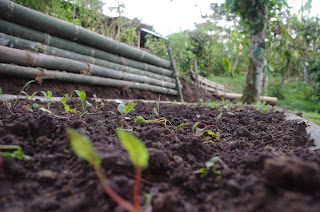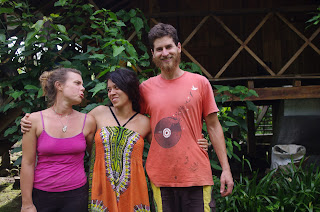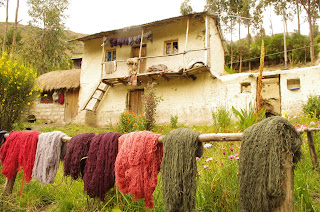Close your eyes, and focus on the sensation in your nostrils
as your breath passes back and forth.
Good, now see how long you can stay focused before your mind
wanders. When your mind wanders,
lovingly, equanimously, bring it back to your breath. Good. Now, continue for an hour. Next, continue for 11 hours a day, for ten
days. Without speaking, without making
eye contact, without eating dinner. This
is, more or less, our experience with Vipassana Meditation. After 30 hours of bus rides to arrive in Cochabamba,
Bolivia, and our
immediate separation upon arrival at the meditation center, left us alone and
daunted, as well as excited and curious.
The schedule starts at 4:30
am, and proceeds until 9 pm,
with a few hours of respite and otherwise continuous, seated meditation. The course is overseen by a female and male
teacher (to assist in maintaining complete separation of the sexes), but the
teacher is G.N. Goenka, who delivers one hour of compelling discourse each day (on tape),
and many chants throughout the meditation. The basic theory is consistent with more
general Buddhist theology – basically (I’m paraphrasing) – that our lives
consist of unnecessary suffering. All
this suffering is caused by the habit patters of the mind, which teach us to
desire things which we find pleasant, or avoid things we find unpleasant. This leads to craving in the first instance,
and aversion in the latter. These
processes are connected through impulses which occur in the brain, causing
physiological changes which make us ‘react’ to given situations. However, upon
introspection one finds that all sensations, in fact everything in life is
impermanent (Goenka calls this the Law of Nature). Thus, reacting to these sensations is sure to
lead to misery, because instead of accepting things for the way they are,
living in the present, the mind is programmed to live in the future or the past
– consistently remembering past pleasures or aversions, or imagining future
ones. In this way, we miss living in the
present. Honestly – think about how
often your mind is thinking about something other than the present… Almost
always, right?
 |
| Goenkaji- the only voice we heard for 10 days, and my does he chant beautifully. |
So, the idea of meditation is to remove oneself from these
patterns by eliminating craving and aversion.
This becomes a practical challenge when facing the (sometimes
excruciating) pain of sitting 11 hours a day, and when facing the craving of
hunger after abstaining from dinner, not to mention the craving of conversation,
physical contact, etc.
Vipassana is unique as a technique because it focuses not
only on the breath when meditating (this is the first three days), but also on
the bodily sensations – which are felt through a method called ‘sweeping’ which
involves locating sensations throughout the body. This process is challenging, because one must
remain equanimous (level-minded) by recognizing that when there is a sensation
of pain or pleasant tingling in any given place in the body, the sensations are
essentially the same, as they are impermanent.
Thus, one shouldn’t desire pleasant sensations, as this creates craving,
nor avoid painful ones, as this creates aversion. Through countless hours of meditation, one
begins to notice more and more bodily sensations, even when not meditating. Thus, one is able to eventually feel the
physiological effects generated through sensation, and slowly eliminate these
‘reactions’ through this physical process.
Vipassana meditators and Buddhists alike will hopefully
forgive my rather crude explanation of the technique – if you desire more
detailed information, check out http://www.dhamma.org/en/vipassana.shtml.
As far as personal experience, I can say that it was the
most physically painful 10 days of my life.
Sitting for so long in meditation pose lead to cramps, knots, and all
kinds of pains. Supposedly, these pains
are reflections of sankaras (mental impurities) being released from the
body. At some sittings, I was able to
establish what Goenka called a “free flow” throughout the body. The theory is that all the body is just
collections of atoms which, if one is sensitive enough, can be felt moving and
constantly changing. Thus, one reaches a
point when the pain ‘dissolves’, as the mind is sensitive enough to feel the
more discrete sensations which combine to create the ‘gross sensation’ of the
pain. This was quite difficult, because
of course I was yearning for the free flow, as it means the pain has gone away,
and despite how many times Goenka assured us that it was ‘equal’ to the painful
state, my mind certainly had this ‘free flow’ as a goal. So, while trying to remain equanimous and
tell myself the pain was the same as the ‘free flow’, I found the pain
remained. Once I finally let go,
surrendering to the idea that the pain would not leave (until the end of the
meditation session – three of which per day required no movement) then the pain
would start to absolve, at which point my mind would become pleased with
progress, and the pain would return. In
this pattern, I faced my aversion to pain (mostly by enduring pain), but also
reached very deep states of meditation which allowed me to face many internal
demons (sankaras) and develop more self-awareness.
Clearly unequanimous were my feelings of the Vipassana
meditation – after a particularly painful meditation, I began wondering how my
knees would survive another 8 days.
Several hours later, after a really successful session, I found myself
considering moving to a Monastery, or never eating meat or raising my voice
again. Claire had a different experience
– she found that as her physical pain dissolved (sometime around day 5), she
had much more trouble staying focused, and this mental acuteness became her
biggest challenge. Of course, I found
this out afterward, as we could not talk (although we did sneak some eye
contact, as the administrators (or fate) put us right next to each other in the
70+ person meditation hall).
On day 9, we were allowed to speak but not have
contact. Claire was crying and we
chatted, and I was still trying to get used to the sound of my own voice in my
head. She described what had been the
hardest 10 days of her life, spent in what she felt bordered somewhere between
a prison and a mental institution (most people walked around the yard with
their heads bowed in silence for much of the free time during the retreat, and
I later learned that some of the women took to waving their arms and ‘flying’
like birds, or crawling across the ground).
Claire felt indoctrinated by the absoluteness of Goenka’s discourses,
which claimed that Vipassana or such a physical sensation meditation technique
was the only way to reach enlightenment.
I guess I was so enthralled by the idea, and so agree with the
methodology, that it bothered me less.
Day 10 came, and we were able to hug. It’s amazing how good that felt. We made many
friends among the people with whom we had shared the past 10 days, but with
whom we had not spoken. It’s amazing how
much you can learn from someone just from the energy they omit. Typical
conversations on day 10 involved deep questions about the meditation, life and
liberation, plans, finding out where we were headed, inviting us to stay if we
passed through, and – oh, by the way – what’s your name? It was as though such formalities didn’t
matter, after passing through such a soul-searching and difficult test together
(albeit completely isolated from one another) we were all brothers and sisters,
united through the trial by fire of Vipassana.
While it was one of the most difficult challenges many of us had ever
faced, it was worth the effort, and all of us gained self-awareness through the
course. In the end, Claire and I both came away with a stronger sense of
ourselves, our challenges and capabilities, and a greater appreciation for one
another.
 |
| Lessons in "metta" the philosophy and practice of unconditional and eternal love to wrap up the course and the practice. |


























